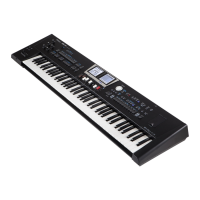Playing the BK-9’s Real-Time Parts
34
Left Display
Right Display
5. Move the sliders below the displays to change volume
for the Rhythm parts (ADRUM, ABASS, ACC1, ACC2, ACC3,
ACC5, ACC5, ACC6)
6. If necessary, you can use the dial to set “SOLO” and
“MUTE” for each Rhythm Part.
7. Press [MIXER] button again to exit to return to the main
page.
If the [MIXER] button indicator doesn’t lights and the sliders are
not assigned to the Harmonic bar ([HARM. BAR] button indicator
doesn’t light), you can use the sliders to adjust the Volume and
Eects of Real Time Parts.
In this case a temporary pop-up window appears:
Left Display
Sound Eects for the real-time parts
The BK-9 has two separate multi-eects processors (MFX 1 and
2) for the real-time parts.
By default the MFX 1 is assigned to the UPPER 1 part and MFX 2
to the UPPER 2.
8. Press the [MFX] button to enable (lights) or disable the
eector.
At power-on, the [MFX] button is automatically switched
9. Press a TONE [0~9] or [USER TONE/SuperNATURAL]
buttons.
A suitable eect is recalled for each tone that you select.
MEMO
By pressing and holding [MFX] button you can access the
display pages where you can set the eects parameters. See
“‘Tone Part Eects’ parameters” (p. 131).
10. Use the dial to select a tone.
A suitable eect is recalled.
MEMO
You can also use the [INC] and [DEC] buttons to change a tone.
11. Use the Sliders MFX1 and MFX2 to control the eects.
The slider MFX1 controls the MFX Control 1.
The slider MFX2 controls the MFX Control 2.
12. If you want to assign another control to the sliders,
press and hold the [MFX] button. See “‘Tone Part Eects’
parameters” (p. 131).
13. Use the Sliders CC1, CC2 and CC3 to control the sound.
The slider CC1 controls the Cut O (Default).
The slider CC2 controls the Resonance (Default).
The slider CC3 controls the Attack (Default).
14. If you want to assign another control to the “CC” sliders,
see “Slider CC1, Slider CC2, Slider CC3” (p. 130).

